This umami-rich, intensely flavorful, and beautifully fragrant homemade vegetable broth takes a handful of aromatics and just 45 minutes on your stove. It’s delicious enough to sip solo, but endlessly handy to keep stocked for risottos, soups, rice, and more.
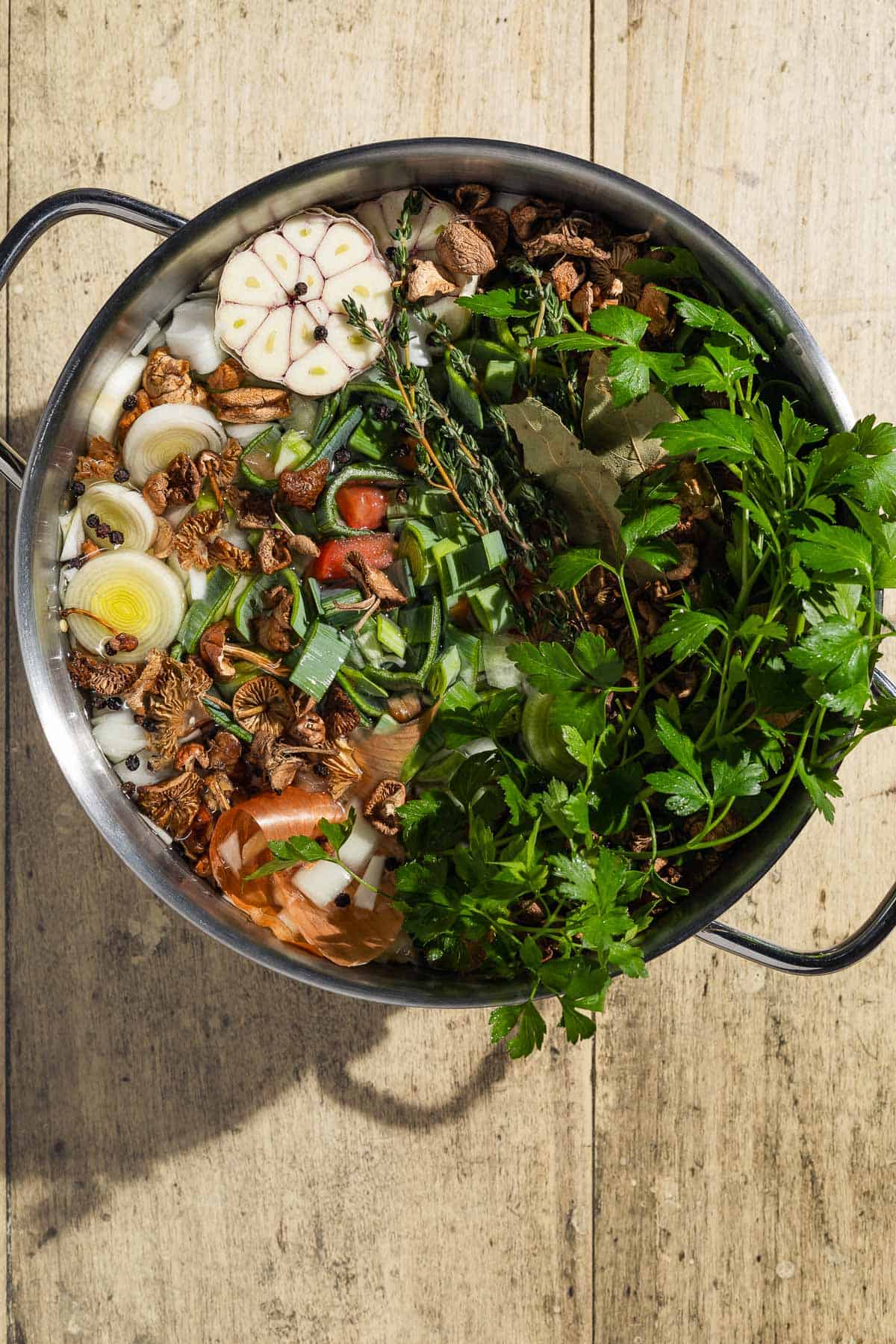
I always like to keep a stash of jars filled with homemade vegetable broth in my freezer. That way I can thaw as needed for soups, asparagus risotto, pan sauces, or just to sip on and warm up on a chilly afternoon.
I tend to make and use vegetable stock more often than chicken stock and seafood stock. I think it’s more versatile, works with a larger variety of dishes, and is extra useful when I have vegetarian guests over. And while I often have odds and ends of vegetables leftover after cooking, I don’t often have chicken carcasses lying around.
Those of us who make homemade stock always gush about how much better it is than store-bought. And it’s true, both in terms of flavor and quality of ingredients, with less salt and no preservatives. But not everyone has the time to tend to a simmering pot for three hours. Luckily, vegetable stock requires much less time–it becomes incredibly flavorful in just 45 minutes.
In addition to the classic aromatic trio of onions, carrots, and celery, I use dried mushrooms and tomato for the base of my stock. Both add a rich umami flavor that you’d otherwise achieve from chicken or meat. Garlic, parsley, thyme, bay leaf, and black pepper perfume the broth for a complex flavor.
Table of Contents
- Vegetable Stock vs. Broth: What’s the Difference?
- Ingredients for Vegetable Broth
- Ingredient Spotlight
- Other Vegetables to Use in Stock
- Tips for How to Make Vegetable Broth
- How to Make Vegetable Broth
- Variation: Roast the Vegetables for a Deeper Flavor
- How to Freeze and Use Vegetable Scraps for Stock
- How to Store and Freeze Vegetable Broth
- Ways to Use Homemade Vegetable Stock
- Stock Your Kitchen with Wholesome Homemade Goodies
- Mediterranean Diet Starter Kit
- How to Make Vegetable Broth Recipe
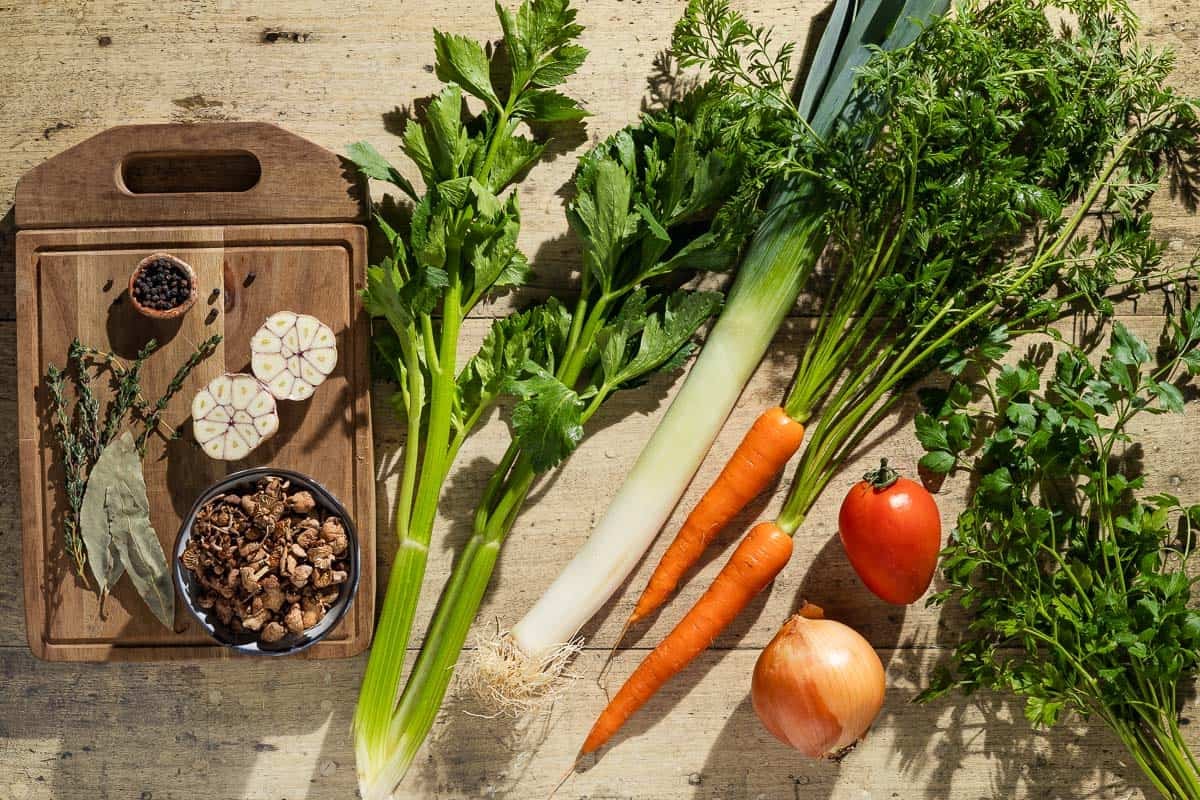
Vegetable Stock vs. Broth: What’s the Difference?
There is no difference between vegetable stock and broth and you can use them interchangeably. Larousse Gastronomique: The World’s Greatest Culinary Encyclopedia, widely considered to be the gold standard for culinary definitions, defines stock as, “A flavored liquid base for making a sauce, stew or braised dish. In general, stocks are aromatic, but not salty, since they have to remain unseasoned until the sauce has been perfected.”
This vegetable broth recipe fits the bill! And if your recipe calls for vegetable stock, this recipe will work perfectly in it.
Note: There is a slight difference between chicken stock, with stock being made from bones and broth being made from meat. But since this vegetable stock/broth is vegan you don’t need to worry about which word you’re using, or which version you use for your recipe.
Ingredients for Vegetable Broth
Celery, carrots, leek, and onion form the aromatic base of this vegetable stock, and dried mushrooms are the powerhouse ingredient, providing savoriness, richness, and color.
- Celery: Celery has a herbaceous flavor with a slight bitterness that balances the sweetness of the carrots and onion. Use the stalk, but skip the leaves, saving them instead for a salad.
- Carrots: The carrots don’t even need to be peeled. Just wash them well to remove any dirt. Don’t use the carrot leaves, but save them to add to Pesto, salad, or Tabouli.
- Leek: Use the whole leek, even the root end and the greens. Dirt and sand get trapped between the layers, so I usually wash leeks well after slicing instead of before. You can also freeze the tops of leeks leftover from making Braised Leeks or Turkish-Style Leeks, and add them to your vegetable stock for zero waste!
- Onion: Use the whole onion, including the root end and the skin, which adds color to the broth.
- Tomato: Adds umami, sweetness, and color.
- Garlic: You could add just a few whole cloves of garlic, but I can’t get enough of it, so a whole head sliced in half crosswise is the perfect amount (skin and all).
- Dried mushrooms: I don’t think we use dried mushrooms quite as much as we should. They pack a savory punch and contribute richness, depth, and color.
- Parsley: Use a small bunch, including the stems and leaves.
- Thyme: Thyme is herbal and floral and doesn’t get bitter or too woody during a long simmer like rosemary might. (I don’t bother with tying a bouquet garni, it’ll be strained out later anyway.)
- Dried bay leaves: Bay leaves seem subtle, but they work wonders in the background to add floral complexity.
- Black peppercorns: Black pepper is more than just heat, the whole peppercorns are earthy, citrusy, and piney. Keeping them whole prevents adding too much of a kick.
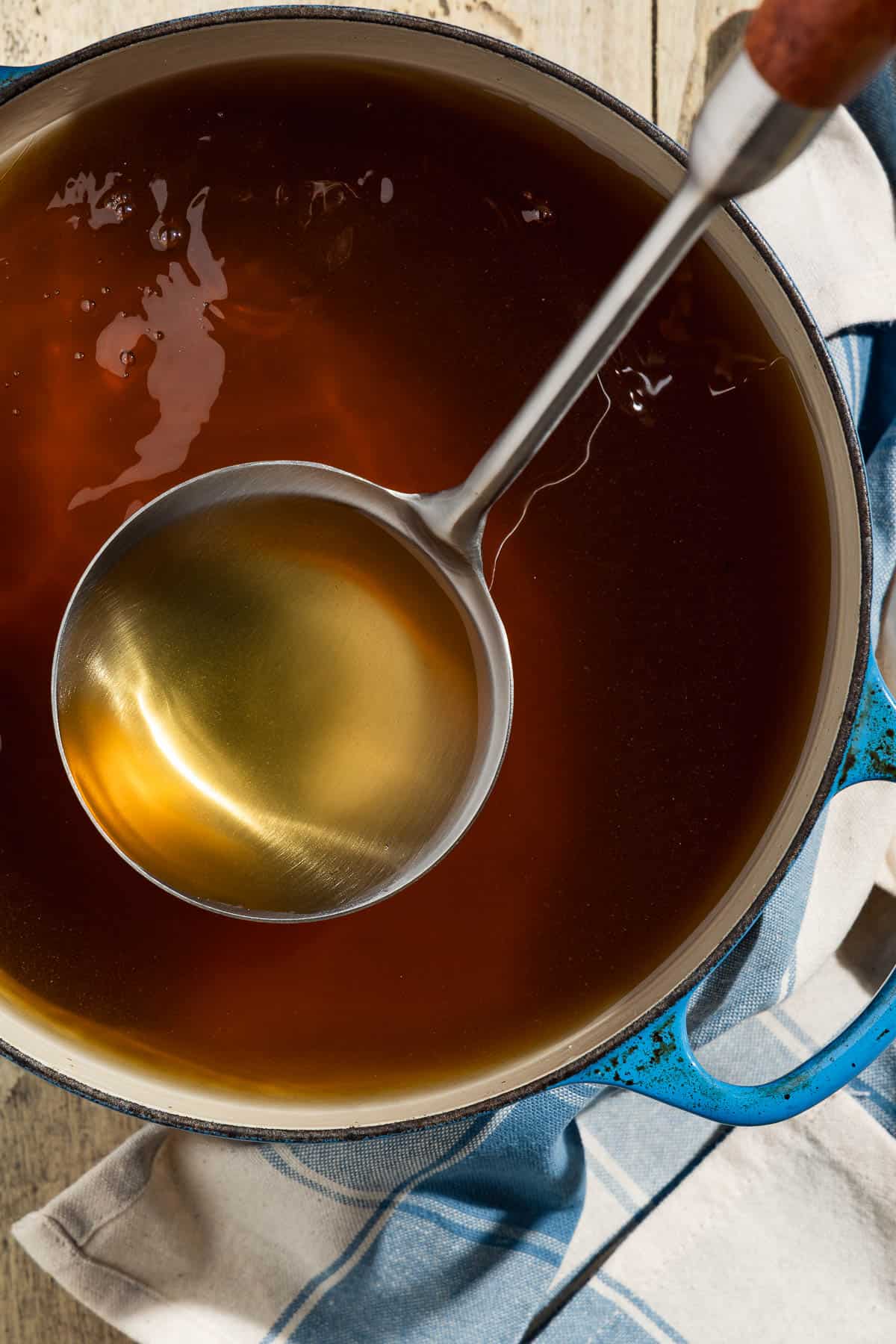
Ingredient Spotlight
Why dried mushrooms? The drying process makes mushrooms richer and more flavorful than their fresh counterparts–think of the bright, sweet, caramelized flavor of sun-dried tomatoes compared with fresh.
I always include dried mushrooms in my vegetable broth to add a savory richness that you would otherwise get from chicken and other meats. You can use any variety of dried mushrooms or a blend. Some common types that should be easy to find are shiitake, porcini, oyster, or morel.
I will admit that dried mushrooms can be expensive. I’ve found that dried shiitake tends to be the most affordable. While you can find them in your grocery store, you may be able to find them cheaper in specialty Asian or European grocery stores or online. When I can get them cheaply, I use a full ounce, but half an ounce will provide plenty of flavor as well.
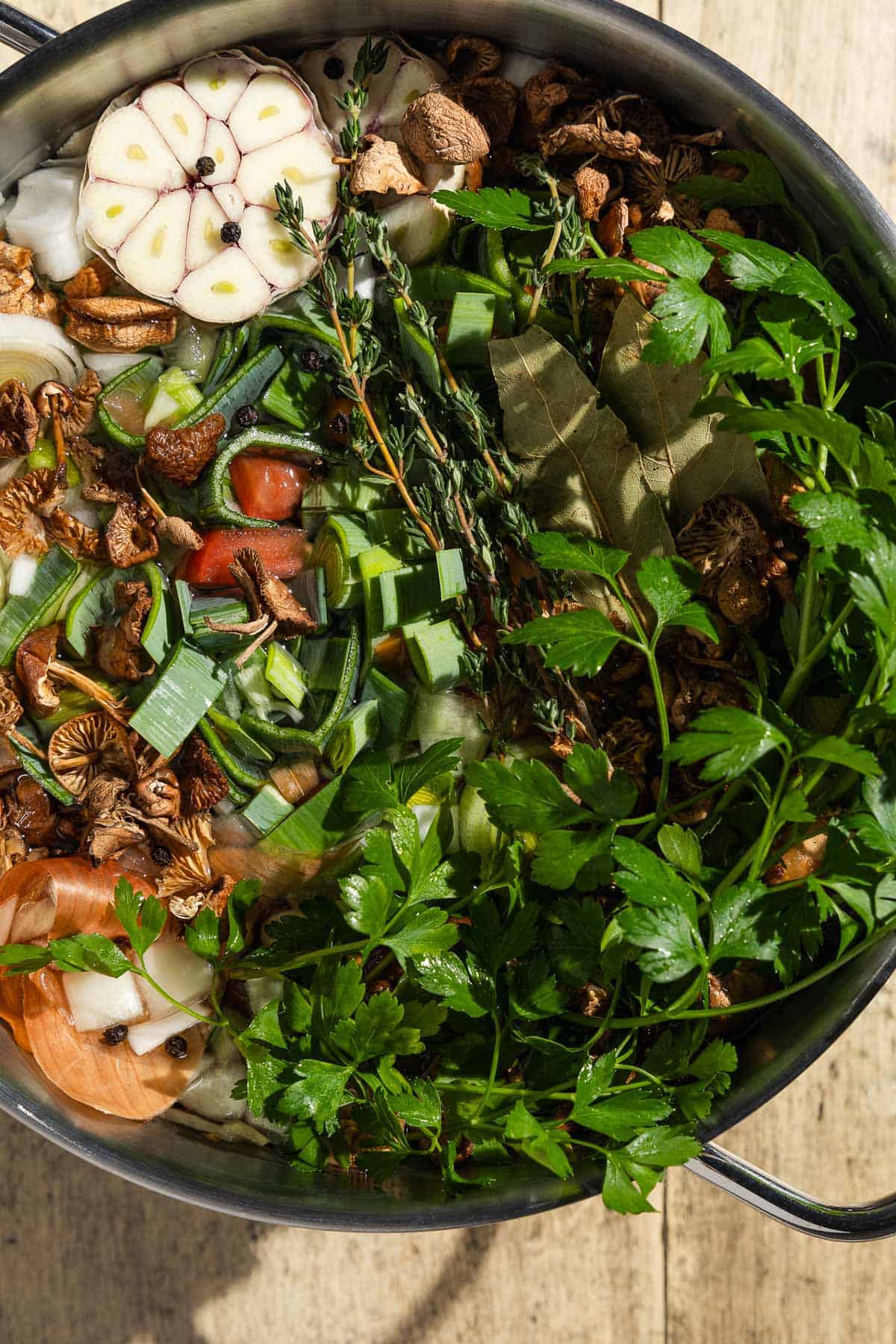
Other Vegetables to Use in Stock
The vegetables I listed for this vegetable broth recipe are my reliable choices for a flavorful, all-purpose stock. But many other vegetables, herbs, and spices can be added to get the flavor you’re after.
- I like to add a piece of kombu, dried sea kelp, which adds an extra boost of umami and thickens the stock slightly. The flavor is subtle and not at all fishy. It’s not Mediterranean, but it can be a nice addition to any vegetable stock.
- Instead of dried, sometimes I use fresh mushrooms or any woody stems I would have tossed out otherwise. To replace the dried mushrooms with chopped fresh mushrooms, use 4 to 8 ounces.
- A teaspoon of fennel seeds adds an herbaceous hint of licorice. Other ways to add sweet licorice flavor is with a fennel bulb or fronds, but don’t use too much, or it could be overwhelming.
- A teaspoon of coriander seeds adds a floral note.
- Sometimes I use a parsnip instead of or in addition to the carrots.
- Almost anything in the allium family is excellent for stocks, but I avoid red onion because of the color.
- It’s not strictly vegetarian, but you can save Parmesan rinds to add more body and umami to the stock. Store them wrapped tightly in your freezer to add to stocks or soups (like Ribollita and Pasta e Ceci).
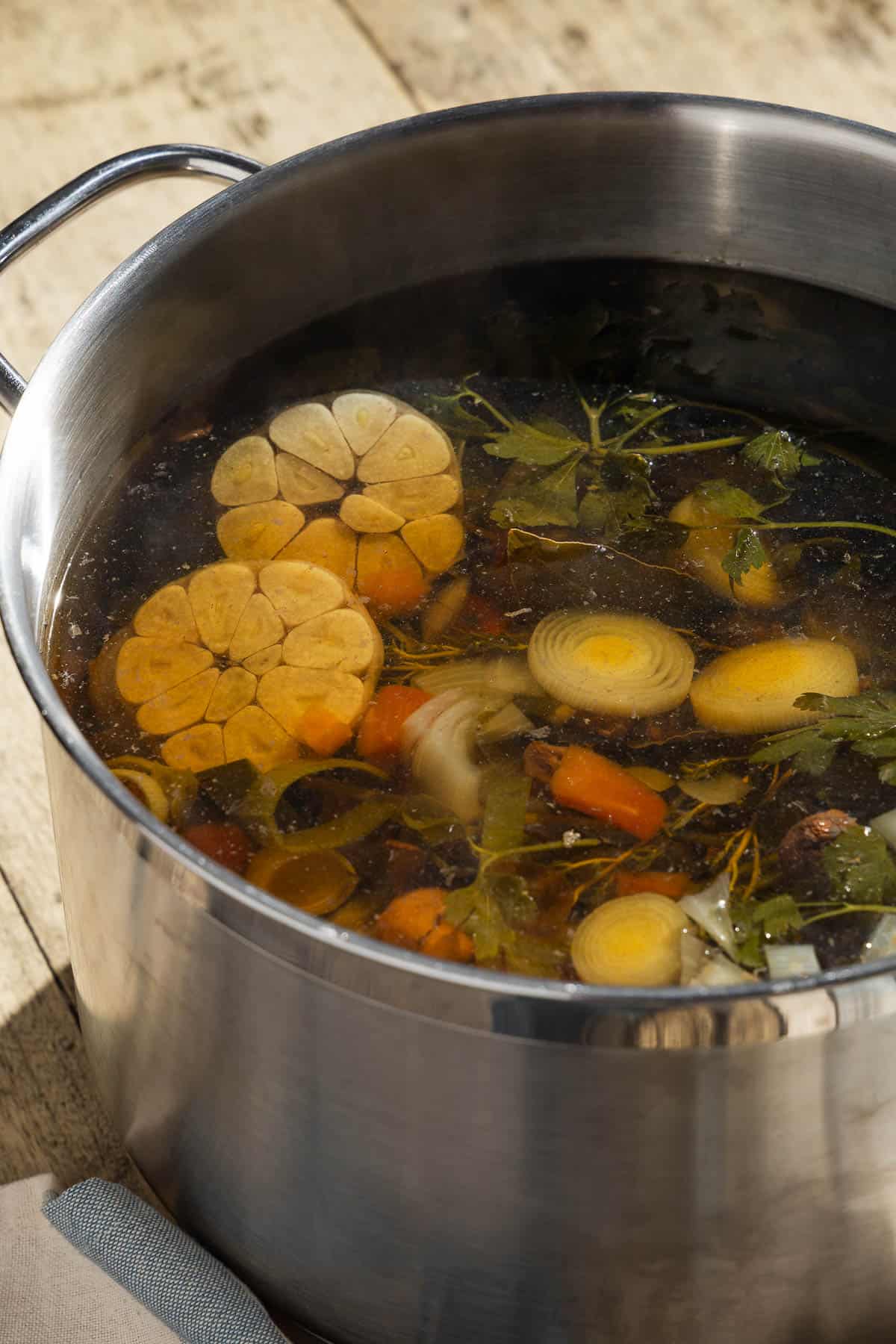
Tips for How to Make Vegetable Broth
Avoid using vegetables that are bitter or overwhelming in flavor or color, that cloud the stock, or that don’t release any flavor. Generally, that means avoiding:
- Cruciferous vegetables like broccoli, cauliflower, radishes, and turnips.
- Starchy vegetables like potatoes and corn.
- Dominant vegetables like beets, peppers, and bitter greens.
How to Make Vegetable Broth
I usually make stock on a relaxing weekend, but since it only has to simmer for 45 minutes, I sometimes make it in the evenings and leave it to gently bubble in the background while I work on something else.
- Wash and finely chop the following, adding to a large stock pot as you go: I don’t bother peeling anything, as there is flavor in the peels, and onion skins turn the stock golden. Add: 2 celery ribs, 2 carrots, 1 onion, and 1 medium tomato. Slice 1 leek (both green and white parts). Slice a whole head of garlic crosswise and add to the pot, leaving its skin on. Add 1/2 to 1 ounce dried mushrooms, 1 bunch parsley (whole), 6 sprigs thyme, 2 dried bay leaves, and 1 teaspoon black peppercorns. Pour enough cold water to cover the vegetables by about 2 inches, 10 to 12 cups.
- Simmer the stock: Set the stockpot over medium-high heat and bring it to a simmer. Once the stock begins to bubble around the edges of the pot, reduce the heat to medium-low and let it simmer for 45 minutes. Adjust the heat as needed to maintain a gentle simmer.
- Strain the stock: Line a mesh strainer with cheesecloth. Set it over a large bowl or another large pot. Pour the stock through the strainer, and press the solids with the back of a spoon to release any additional liquid. You should have between 8 and 10 cups of stock.
- Store: Transfer the broth into jars or freezer-safe containers. Let it cool completely, then store it in the fridge or freezer. The vegetable stock recipe will keep in the refrigerator for up to 1 week, or in the freezer for up to 4 months. If freezing, leave extra room in the containers for the stock to expand.
Variation: Roast the Vegetables for a Deeper Flavor
Roasting the vegetables gives a deeply colored vegetable stock full of caramelized flavor that’s perfect for richer dishes. To do so:
- Toss the chopped celery, carrots, leek, onion, tomato, and halved garlic with a drizzle of olive oil on a parchment-lined sheet pan.
- Roast in a 425°F oven for 40 minutes, stirring occasionally, until they’re browned and caramelized.
- Transfer to the stockpot, add the remaining ingredients, and make the stock as directed.
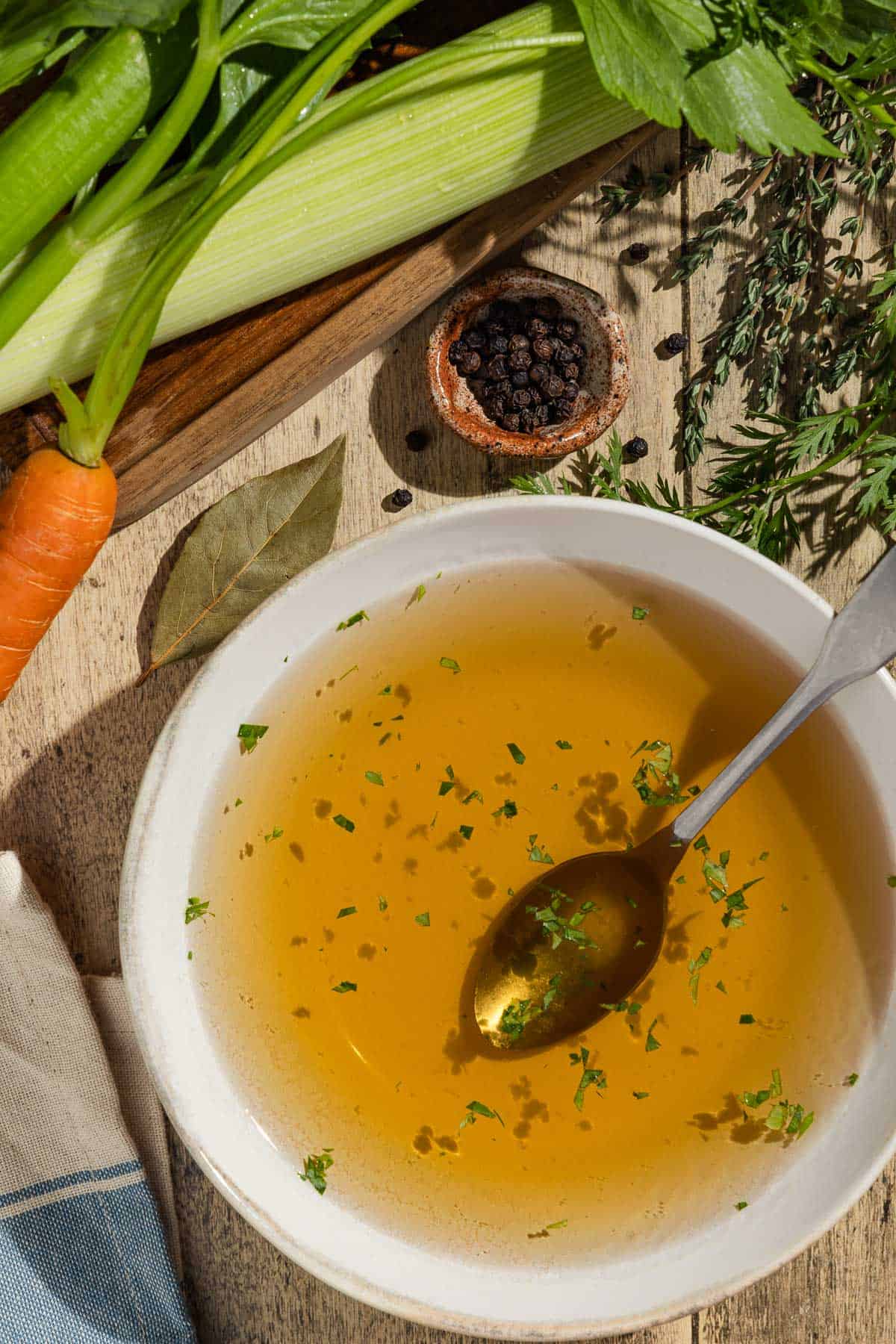
How to Freeze and Use Vegetable Scraps for Stock
I’m lucky to have curbside compost collection in my city and have been feeling better about how my food waste is put to use. But whether or not you have the space for or access to composting, there’s still plenty of flavor that can be unleashed from many of those food scraps before tossing them.
I keep a zip-top bag in the freezer that I fill with kitchen scraps to save for making this vegetable broth recipe, dumping the contents of the bag into the simmering stock for the last 15 minutes. Because they’re small, thin pieces that have been frozen and thawed, they break down quickly, so I don’t add them at the beginning.
You can save scraps from any of the vegetables in the ingredient list or the list of add-ins. For example, save carrot peels, tips, and tops, onion roots and skins, garlic skins, celery ends, mushroom stems, parsley stems, and leek roots and greens.
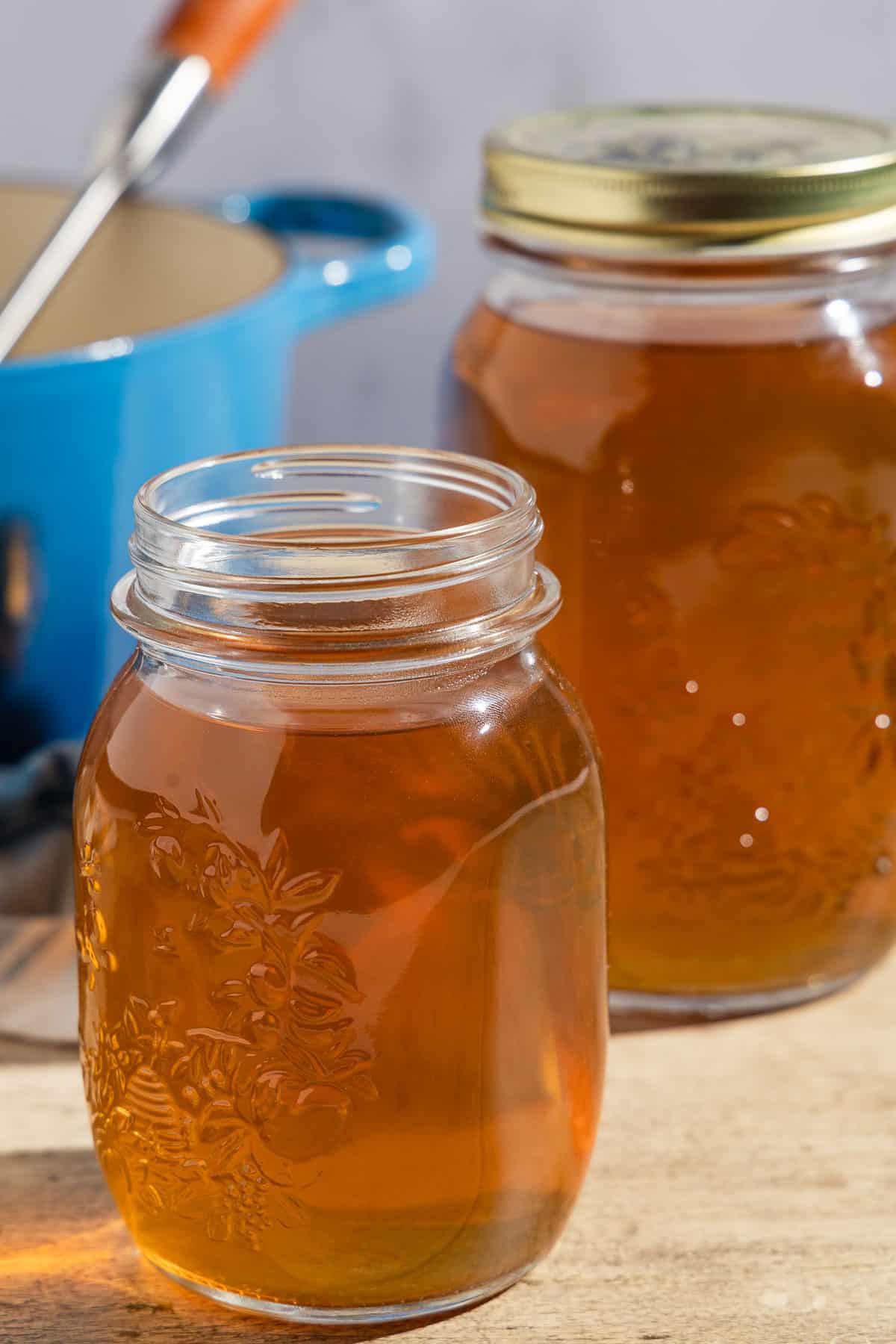
How to Store and Freeze Vegetable Broth
Every time I make stock, I store a jar in my fridge to use within the week. What remains goes in my freezer so that I can thaw as needed.
The stock will keep in the refrigerator for up to 1 week, or in the freezer for up to 4 months. I like to freeze it pre-measured in a volume that I use often, for example, 1 or 2 cups. A few things to remember:
- Leave extra room in the containers for the broth to expand when it freezes.
- Be mindful of the limits of the containers you’re using. If using glass, make sure it’s tempered glass. If you plan on thawing the stock in the microwave, make sure it’s safe to microwave directly from the freezer.
- To thaw: If you have time, the best way to thaw vegetable broth is in the refrigerator for 1 to 2 days. I never remember until it’s too late, so I usually defrost it in warm water until I can get it out of the jar, then finish thawing it in a pot over medium-low heat.
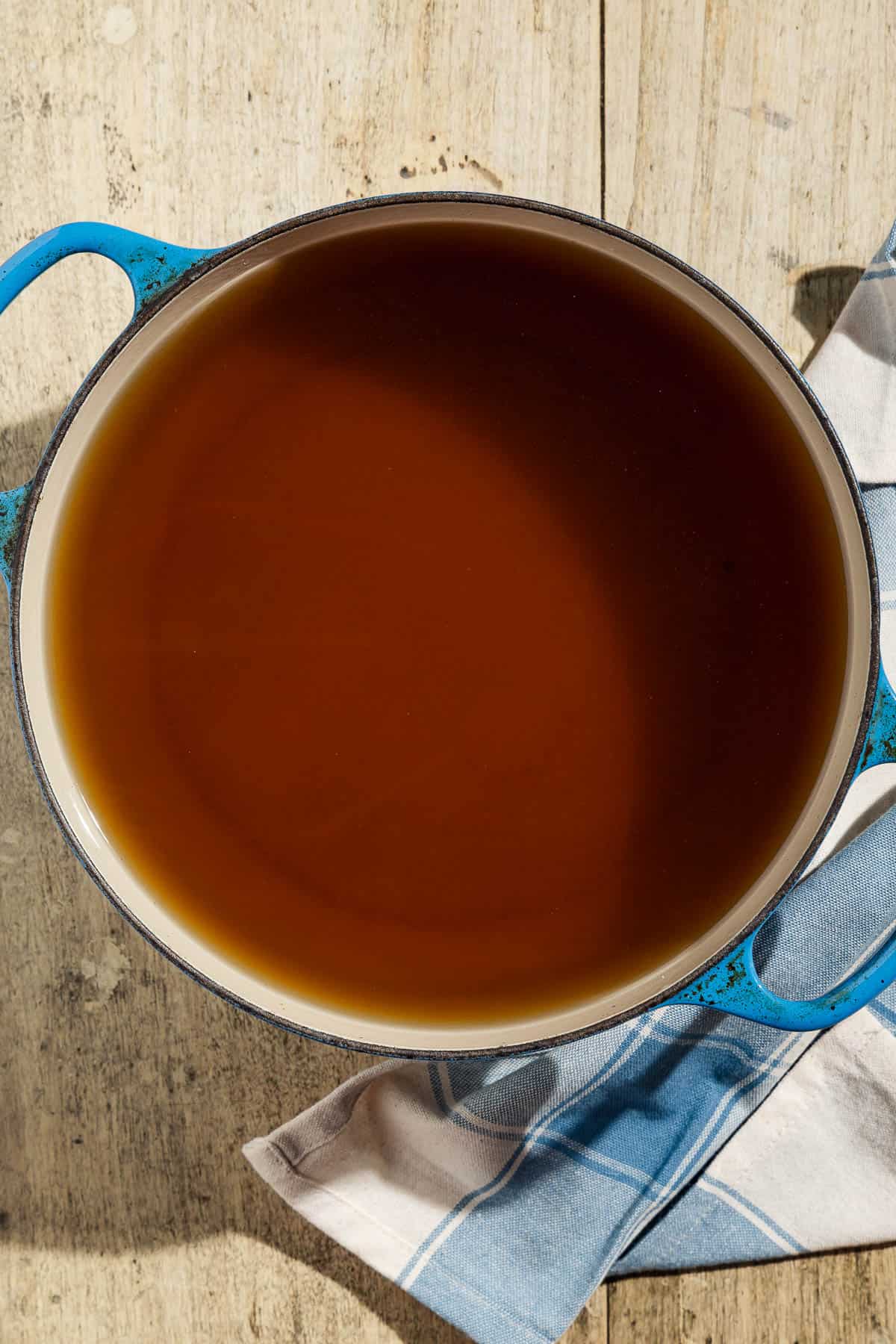
Ways to Use Homemade Vegetable Stock
You can use this vegetable broth recipe just as you would chicken stock–and in many cases for savory recipes, just as you would water for an added flavor-boost. Here are some go-tos:
- Soup: We have a number of vegetarian soup recipes, from brothy vegan soups like Cabbage Soup with Turmeric and Ginger and Vegetable Stew with Peas, to velvety green Asparagus Soup, to comforting and hearty Pappa al Pomodoro (Italian Bread and Tomato Soup).
- Vegetarian Risotto: Like mushroom, butternut squash, or asparagus.
- In place of water in savory recipes: Like Salmorejo (Spanish Chilled Tomato Soup) or Saffron Rice.
Stock Your Kitchen with Wholesome Homemade Goodies
Soups and Stews
How to Make Chicken Stock
Dips and Condiments
Homemade Harissa Recipe (Video)
Dips and Condiments
Homemade Labneh
Browse all Mediterranean recipes.
Visit Our Shop.
Mediterranean Diet Starter Kit
Stock your pantry with the essentials to eat the Mediterranean way, including Greek olive oil, 7 spices, and tahini.
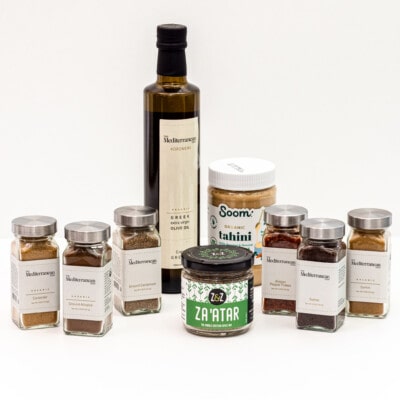
How to Make Vegetable Broth

Equipment
- Cheesecloth for straining
Ingredients
- 2 celery ribs, finely chopped
- 2 large carrots, finely chopped
- 1 leek, sliced into thin rounds (both white and green parts)
- 1 onion, finely chopped
- 1 medium tomato, finely chopped
- 1 whole head garlic, halved crosswise
- 1/2 to 1 ounce dried mushrooms
- 1 small bunch fresh parsley, (both stems and leaves)
- 6 sprigs fresh thyme
- 2 dried bay leaves
- 1 teaspoon black peppercorns
- 10 to 12 cups cold water
Instructions
- Gather the vegetables: Into a large stock pot, add the celery, carrots, leek, onion, tomato, garlic, dried mushrooms, parsley, thyme, bay leaves, and black peppercorns. Pour enough cold water to cover the vegetables by about 2 inches, 10 to 12 cups.
- Simmer the stock: Set the stockpot over medium-high heat and bring it to a simmer. Once the stock begins to bubble around the edges of the pot, reduce the heat to medium-low and let it simmer for 45 minutes. Adjust the heat as needed to maintain a gentle simmer.
- Strain the stock: Line a mesh strainer with cheesecloth. Set it over a large bowl or another large pot. Pour the stock through the strainer. Press the solids to release any additional liquid. You should have between 8 and 10 cups of stock.
- Store: Transfer the stock into jars or freezer-safe containers. Let the stock cool completely, then transfer to the fridge or freezer. The stock will keep in the refrigerator for up to 1 week, or in the freezer for up to 4 months. If freezing, leave extra room in the containers for the stock to expand.
Notes
- While I always make stock on the stove, you can make vegetable stock in a slow cooker. Add all of the ingredients to the slow cooker and pour in 8 cups of cold water. Cook on high for 4-6 hours or low for 6-8 hours.
- You can save scraps from any of the vegetables in the ingredient list or the list of add-ins. For example, save carrot peels, tips, and tops, onion roots and skins, garlic skins, celery ends, mushroom stems, parsley stems, and leek roots and greens. To make this stock using food scraps:
- Keep a zip-top bag in the freezer to fill with kitchen scraps for making stock.
- Dump the contents of the bag into the simmering stock for the last 15 minutes. Because they’re small they will break down quickly, so I don’t add them at the beginning.
- To thaw: If you have time, the best way to thaw vegetable stock is in the refrigerator for 1 to 2 days. I never remember until it’s too late, so I usually defrost it in warm water until I can get it out of the jar, then finish thawing it in a pot over medium-low heat.
- Visit our shop to browse quality Mediterranean ingredients including olive oils, honey, jams, and spices.



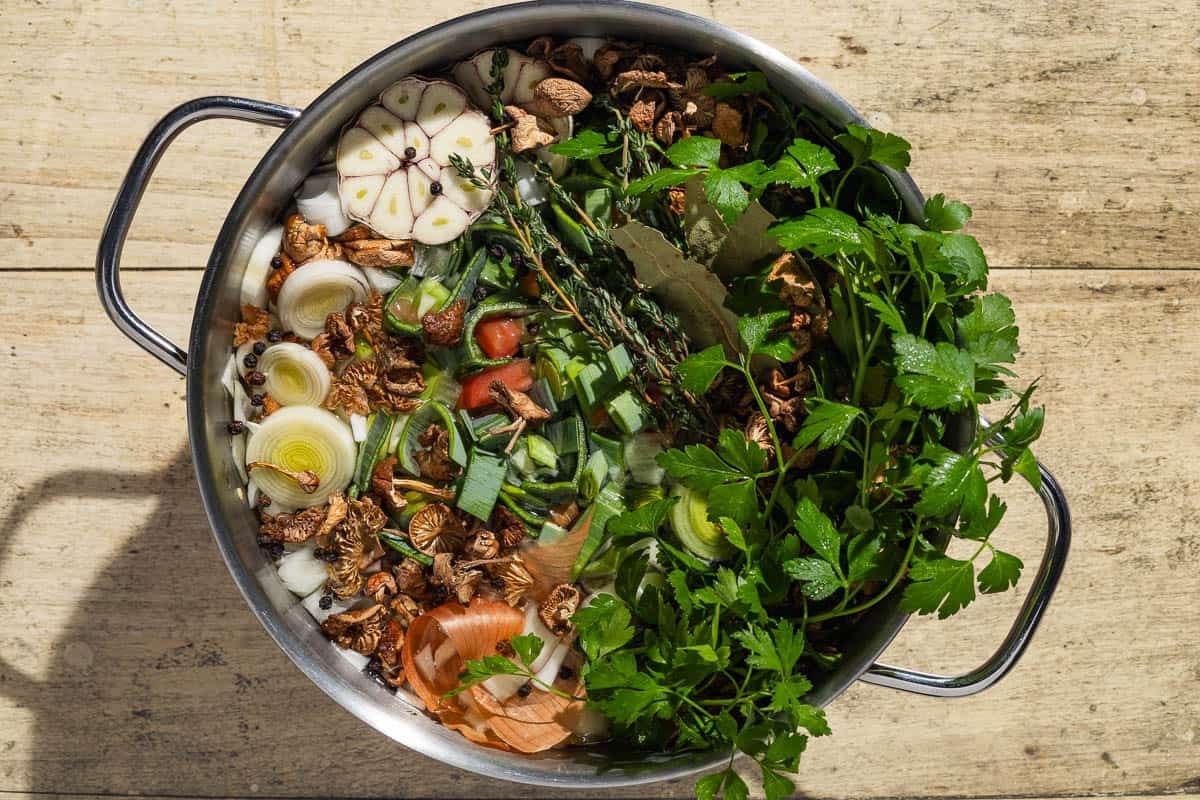
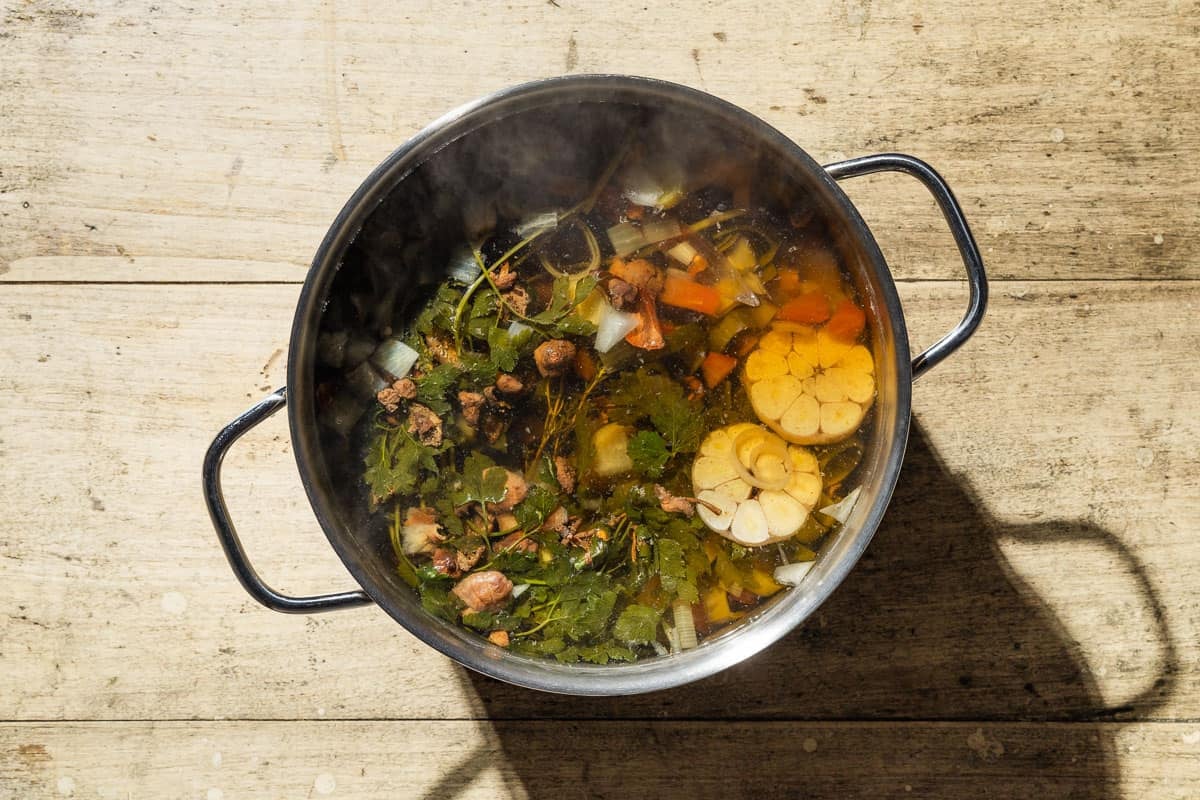
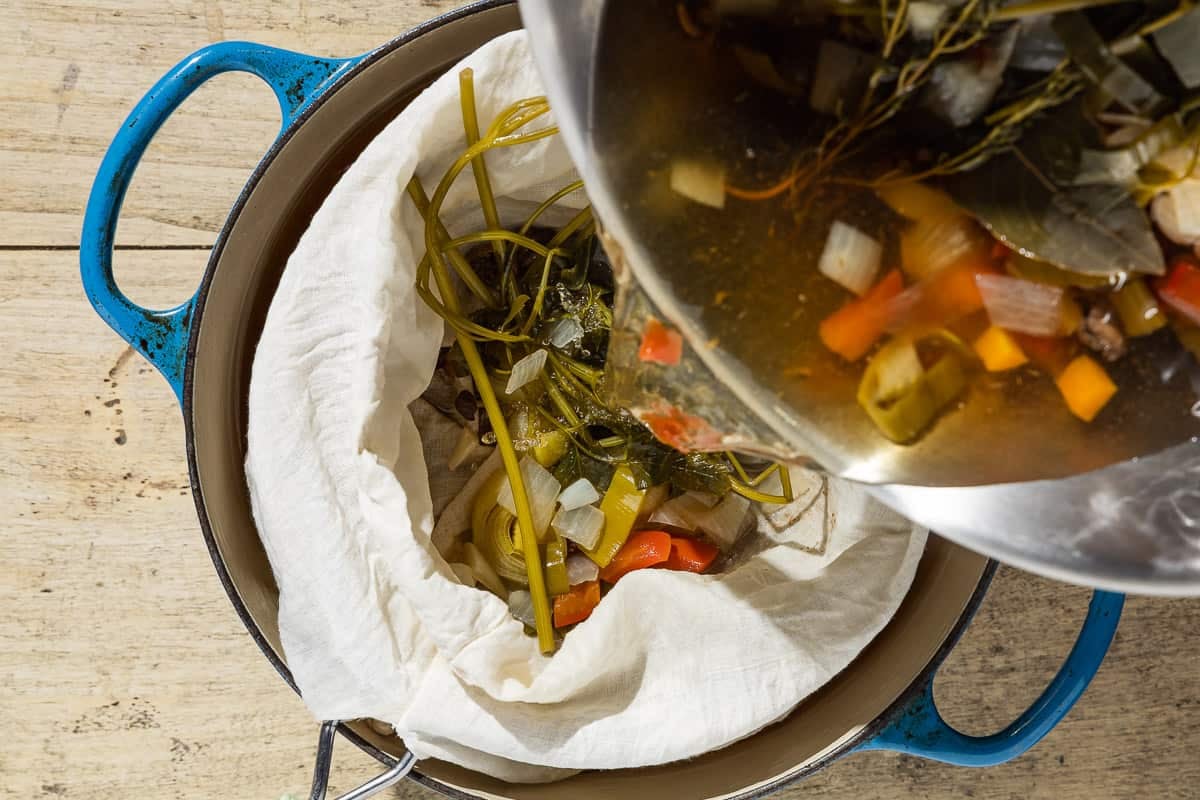
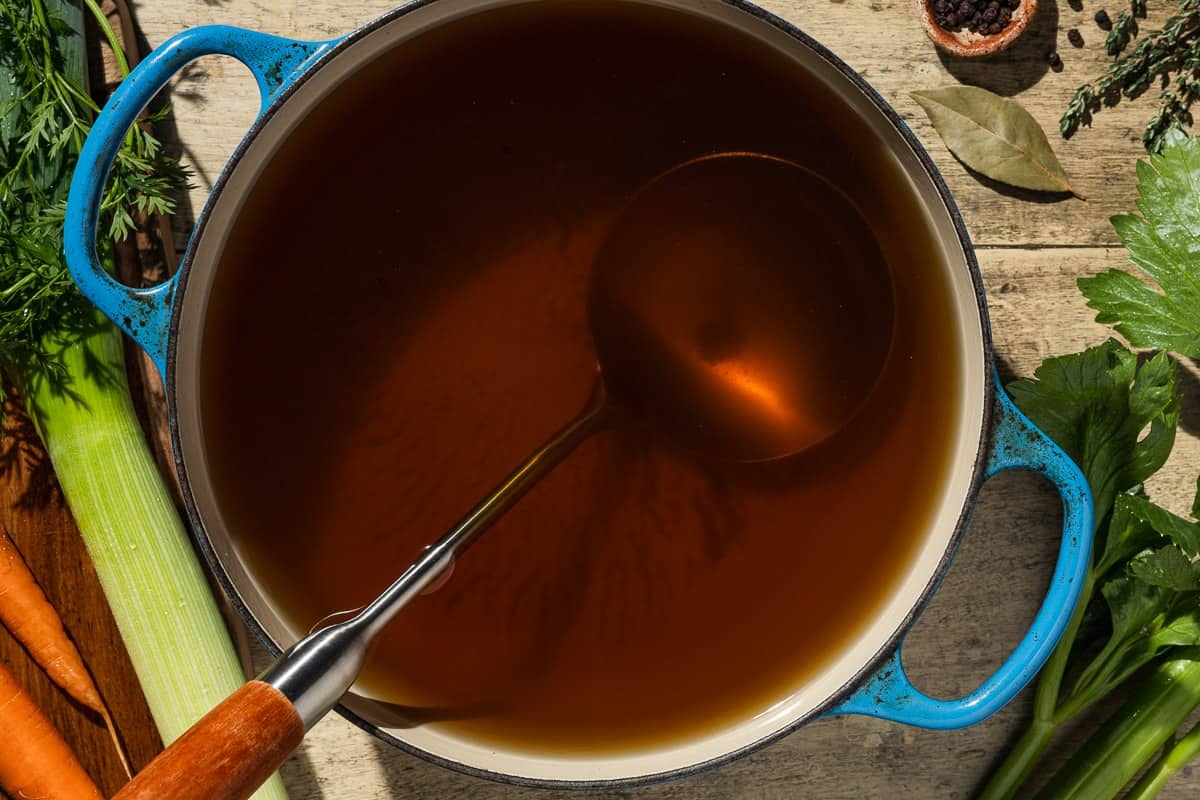
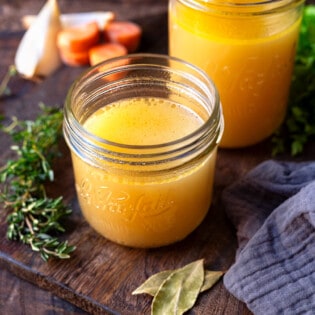
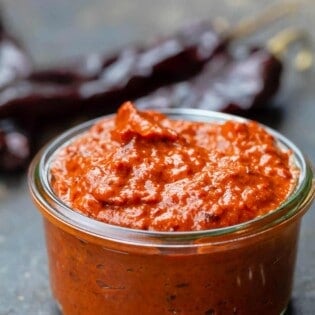
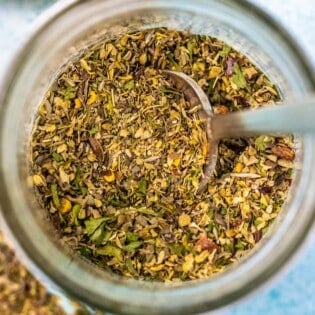
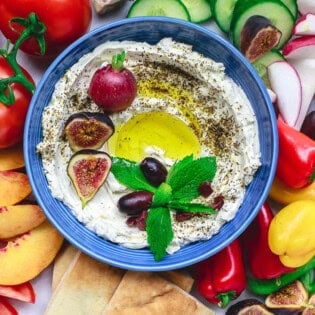
Can I use more onion if I don’t have leeks? If so, how much?
Can you use frozen butter beans instead of canned?
Very nice recipe chef 👍👌👏. Thank you for your effort 🌞😎.